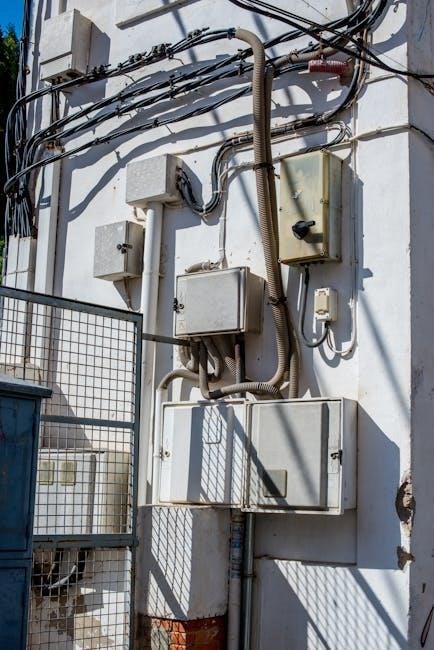
nvq level 3 electrical installation portfolio examples pdf
The NVQ Level 3 Electrical Installation is a comprehensive qualification that assesses practical skills, safety protocols, and regulatory knowledge in electrical work; It requires building a detailed portfolio showcasing real-world tasks and projects, demonstrating competence in installation, maintenance, and troubleshooting. This qualification is essential for aspiring electricians aiming to achieve industry-recognized standards and advance their careers in the electrical trade.
Overview of NVQ Level 3 Electrical Installation
The NVQ Level 3 Electrical Installation qualification is designed to assess occupational competence in electrical installation work. It focuses on practical skills, safety standards, and adherence to industry regulations. The portfolio-based assessment requires candidates to demonstrate their ability to perform complex electrical tasks, such as installations, inspections, and fault diagnosis. This qualification is ideal for individuals aiming to progress in their electrical careers, as it validates their expertise and readiness for advanced roles in the trade.
Significance of the NVQ Level 3 Portfolio
The NVQ Level 3 portfolio is a critical showcase of an electrician’s competency, demonstrating adherence to industry standards and safety protocols. It serves as evidence of practical skills, problem-solving abilities, and compliance with regulatory requirements. By documenting real-world tasks and projects, the portfolio validates an individual’s readiness for advanced roles in electrical engineering. It is essential for career progression, as it highlights expertise and professionalism, making it a vital tool for employability and professional credibility in the electrical trade.

Understanding the NVQ Level 3 Portfolio Requirements
The NVQ Level 3 portfolio requires candidates to submit work-based evidence, including practical tasks and documentation, to meet specific assessment criteria, ensuring competency in electrical installation practices.
Key Components of the Portfolio
The NVQ Level 3 Electrical Installation portfolio must include detailed work-based evidence, such as job descriptions, photographs, and witness statements. Practical assessments, like the AM2, are also required. Candidates must document their involvement in installations, maintenance, and fault diagnosis. Each entry should clearly demonstrate how the candidate meets the assessment criteria. The portfolio must be well-organized, with evidence mapped to specific units. Including reflective accounts and professional discussions adds depth. Ensure all evidence is authentic, dated, and signed by a qualified witness to validate competence.
Evidence Requirements for NVQ Level 3
The NVQ Level 3 Electrical Installation requires robust evidence, including detailed job descriptions, photographs, and witness statements. Practical assessments like the AM2 are mandatory. Candidates must provide proof of involvement in complex installations, maintenance, and fault diagnosis. Evidence must be authentic, dated, and signed by a qualified witness. Reflective accounts and professional discussions should be included to demonstrate understanding. The portfolio must clearly map evidence to specific units. Ensuring evidence meets assessment criteria is crucial for validation and achieving the qualification.

Building Your NVQ Level 3 Electrical Installation Portfolio
Start by organizing work-based evidence, including job descriptions, photographs, and witness statements. Use templates to ensure a structured approach, meeting assessment criteria effectively.
Structuring Your Portfolio for Success
Organize your portfolio into clear sections, such as Installation Projects, Maintenance Activities, and Safety Procedures. Use subheadings and bullet points for clarity. Include photographs, diagrams, and witness statements to support your evidence. Ensure each entry is dated and clearly linked to the assessment criteria. Use templates to maintain consistency and professionalism. Regularly review and update your portfolio to avoid last-minute rushes. A well-structured portfolio demonstrates your competence and attention to detail, enhancing your chances of a successful assessment.
Documenting Work-Based Evidence
Documenting work-based evidence requires clear, detailed records of your electrical installations and maintenance tasks. Include dates, locations, and specific tasks performed. Use photographs, diagrams, and witness statements to validate your work. Record observations, measurements, and compliance with safety standards. Maintain organized digital or physical files, ensuring easy access for assessment. Regularly update your portfolio with new projects, reflecting your progression and competence. This structured approach ensures your evidence meets the NVQ Level 3 criteria, showcasing your practical skills effectively.
Common Challenges in Completing the NVQ Level 3 Portfolio
One of the most common challenges is managing time effectively while balancing work and portfolio preparation. Learners often struggle to organize evidence systematically, leading to delays. Procrastination and the complexity of evidence requirements can overwhelm candidates. Creating a structured schedule and breaking tasks into smaller, manageable steps can help maintain progress; Regularly updating the portfolio and seeking guidance from assessors are key strategies to avoid last-minute pressures and ensure timely completion of the NVQ Level 3 portfolio.
Time Management and Organization
Time management and organization are critical challenges when completing the NVQ Level 3 portfolio. Balancing work commitments with evidence collection can be overwhelming, especially with the volume of documentation required. Many learners struggle to prioritize tasks, leading to procrastination and last-minute rushes. To overcome this, creating a structured schedule and breaking tasks into smaller, manageable steps is essential. Regularly updating the portfolio and seeking feedback from assessors can help maintain progress and ensure all requirements are met efficiently. Staying organized and proactive is key to avoiding delays and achieving success.
Understanding Assessment Criteria
Understanding the assessment criteria is crucial for successfully completing the NVQ Level 3 Electrical Installation portfolio. Assessors evaluate evidence based on industry standards, technical accuracy, and adherence to safety protocols. Candidates must demonstrate competence in installation, testing, and maintenance tasks, as well as problem-solving skills. The portfolio must clearly show how each unit’s requirements are met through detailed, well-organized evidence. Familiarizing oneself with the assessment handbook and seeking clarifications from mentors can ensure alignment with expectations and improve the likelihood of achieving the qualification.

Submission and Assessment of the NVQ Level 3 Portfolio
The NVQ Level 3 portfolio is submitted for assessment after compiling all required evidence. Assessors evaluate work-based evidence and practical skills demonstrated in the portfolio, ensuring compliance with industry standards. The AM2 practical assessment is also a critical component, testing hands-on abilities in a controlled environment. Successful completion of both the portfolio and AM2 leads to the award of the qualification.
Preparing for the AM2 Practical Assessment
Preparing for the AM2 practical assessment requires rigorous practice of hands-on electrical tasks, such as installation, inspection, and testing. Candidates should familiarize themselves with the assessment format, which includes timed practical exercises and scenario-based challenges. Reviewing safety protocols and industry standards is crucial. Practicing under real-world conditions helps build confidence and efficiency. Additionally, studying the IET Wiring Regulations and understanding the mark scheme ensures alignment with assessor expectations. Seeking feedback from mentors or assessors can also refine preparation strategies.
What to Expect During the Assessment Process
The NVQ Level 3 assessment involves both practical and theoretical evaluations to confirm competence. The AM2 practical assessment is a critical component, requiring candidates to complete timed tasks in a controlled environment. These tasks include electrical installations, inspections, and testing, adhering to safety protocols and industry standards. Assessors observe and evaluate accuracy, efficiency, and adherence to regulations. Additionally, the portfolio is reviewed for completeness and relevance to the qualification criteria. Candidates should prepare by understanding the mark scheme and practicing under timed conditions to build confidence and proficiency.

Examples of Successful NVQ Level 3 Portfolios
Successful portfolios include detailed documentation of work-based evidence, such as installations, inspections, and problem-solving tasks. Examples like Jason’s apprenticeship showcase practical competence and adherence to safety standards.
Case Studies of Achieved Portfolios
Case studies reveal how successful candidates structured their portfolios. For example, Jason completed his NVQ Level 3 apprenticeship, documenting installations and inspections. His portfolio showcased practical competence, adhering to safety and regulatory standards. Another candidate demonstrated problem-solving skills through detailed task descriptions. These examples highlight the importance of clear, organized evidence and adherence to assessment criteria, providing valuable insights for aspiring electricians aiming to achieve their qualification.
Best Practices for Portfolio Presentation
Presenting a well-organized and visually appealing portfolio is crucial. Use clear headings, divide content into logical sections, and ensure all evidence is easily accessible. Include high-quality photos and diagrams to support written descriptions. Proofread for clarity and professionalism. Utilize digital tools to enhance presentation, such as e-portfolios, while maintaining consistency in formatting. Ensure all work meets safety and regulatory standards, showcasing attention to detail and competence. A polished portfolio reflects professionalism and readiness for advanced roles in electrical engineering.
Top Tips for Creating a Standout NVQ Level 3 Portfolio
Leverage online resources and templates to streamline portfolio creation. Use City & Guilds’ online system for structured evidence submission. Templates ensure consistency and professionalism, saving time and reducing errors. Access sample portfolios for inspiration and guidance. Online tools also offer real-time feedback, helping you meet assessment criteria effectively. Regularly update your portfolio using digital platforms to maintain organization and clarity, ensuring all evidence aligns with NVQ Level 3 requirements.
Utilizing Online Resources and Templates
Online resources and templates are invaluable for creating a standout NVQ Level 3 portfolio. City & Guilds offers e-portfolio platforms and sample templates to guide you. Websites like MyPortfolio and OneFile provide structured frameworks to organize evidence digitally. Templates ensure consistency in presentation, saving time and reducing errors. Additionally, online forums and community groups share examples and tips, offering insights into successful portfolio submissions. Leverage these tools to streamline your process, meet assessment criteria, and present a professional, well-organized portfolio that highlights your skills effectively.
Seeking Feedback from Mentors or Assessors
Seeking feedback from mentors or assessors is crucial for refining your NVQ Level 3 portfolio. Regularly review your work with your assessor to ensure alignment with assessment criteria. Mentors can provide insights into strengths and areas for improvement, helping you address gaps in evidence or documentation. Asking specific questions, such as clarity of documentation or depth of technical detail, can yield targeted feedback. This collaborative approach ensures your portfolio is polished, professional, and meets the required standards for successful assessment and qualification.
The Impact of NVQ Level 3 on Your Electrical Career
The NVQ Level 3 qualification significantly enhances job prospects, demonstrating expertise and commitment to employers. It opens doors to senior roles, increases earning potential, and builds a strong foundation for career advancement in electrical engineering.
How the Qualification Enhances Job Prospects
The NVQ Level 3 Electrical Installation qualification significantly boosts job prospects by validating practical and theoretical expertise. It demonstrates a candidate’s ability to meet industry standards, making them highly attractive to employers. This certification opens opportunities for senior roles in electrical contracting, construction, and industrial sectors. It also enhances portability across regions, as the qualification is recognized nationwide. Employers value the assurance of competence, safety, and regulatory compliance, making NVQ Level 3 holders stand out in a competitive job market and aiding career progression.
Transitioning to Advanced Roles in Electrical Engineering
Completing the NVQ Level 3 Electrical Installation qualification paves the way for transitioning into advanced roles within electrical engineering. It equips individuals with the necessary skills and knowledge to move beyond basic electrical tasks, enabling them to take on more complex projects and responsibilities. The portfolio serves as a testament to their capabilities, allowing them to pursue roles such as senior electricians, technical supervisors, or specialized engineers. This qualification also opens pathways for further certifications and leadership positions, enhancing career growth and opportunities in the field.
Maintaining and Updating Your NVQ Level 3 Portfolio
Regularly updating your NVQ Level 3 portfolio ensures it reflects your evolving skills and knowledge in electrical installation. This practice helps in tracking professional growth and readiness for advanced roles.
Continuous portfolio maintenance also prepares you for future assessments and career opportunities, demonstrating your commitment to ongoing learning and adaptation in the electrical engineering field.
Continuous Professional Development
Maintaining your NVQ Level 3 portfolio supports continuous professional development by documenting new skills and experiences. Regular updates ensure your portfolio reflects industry advancements and evolving standards, showcasing your adaptability and commitment to growth. This practice not only enhances your expertise but also prepares you for higher-level qualifications or specialized roles, demonstrating to employers your dedication to staying current and competent in electrical installation practices.
Leveraging Your Portfolio for Future Opportunities
Your NVQ Level 3 Electrical Installation portfolio is a valuable asset for future career opportunities. It serves as a comprehensive record of your skills and experiences, making it easier to demonstrate your expertise to potential employers or clients. By showcasing your practical abilities and adherence to industry standards, the portfolio can open doors to advanced roles, specialized projects, or further professional development. Regularly updating and refining it ensures you remain competitive and prepared for new challenges in the electrical trade.
Completing the NVQ Level 3 Electrical Installation portfolio marks a significant milestone, showcasing your skills and readiness for advanced roles in the electrical industry.
Final Thoughts on Completing the NVQ Level 3 Portfolio
Completing the NVQ Level 3 portfolio is a testament to dedication and expertise in electrical installation. It validates practical skills, ensuring compliance with industry standards. The process, while challenging, equips professionals with a comprehensive record of their work, enhancing credibility and career prospects. By meticulously documenting tasks and projects, individuals demonstrate their ability to meet rigorous assessment criteria, ultimately solidifying their status as competent electricians in the competitive job market. This achievement is a significant step toward professional growth and recognition within the electrical engineering field.
Encouragement for Aspiring Electricians
Embarking on the NVQ Level 3 Electrical Installation journey is a bold step toward a rewarding career. Aspiring electricians should embrace this opportunity to showcase their skills and dedication. The portfolio process, though demanding, is a gateway to professional growth and recognition. Stay persistent, leverage online resources, and seek mentorship to excel. Remember, completing this qualification opens doors to advanced roles and enhances your credibility in the field. Your hard work will pave the way for a successful and fulfilling career as a skilled electrician.
Leave a Reply
You must be logged in to post a comment.